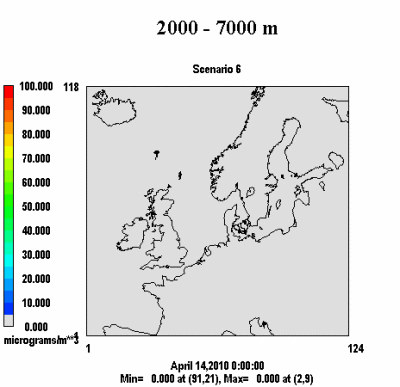GKSS scientists make statements on concentration of ash particles after volcanic eruption
Some German airlines levelled their criticism against the forecasts of the Volcanic Ash Advisory Centre (VAAC) in London on the spread of the ash cloud over Europe, as these forecasts did not provide any precise information on the ash concentration in the atmosphere. Scientists at the GKSS Research Centre Geesthacht managed to reconstruct the spread process and make statements on the concentration of ash particles.

Dynamic of the ash cloud at a height between 2,000 and 7,000 metres; 14–21 April 2010 Foto: HZG/Volker Matthias
As a result of the eruption of the Icelandic volcano Eyjafjallajökul, from mid-April 2010 to the end of the same month, an ash cloud spread across Europe which resulted in severe disruptions to air travel. As the ash can damage jet engines, aircraft were not allowed to cross the airspace for a long time. Airports remained closed. Some German airlines doubted the necessity of restricting flight movements.
The VAAC monitors the movement of volcanic ash clouds for the international aviation and supplies the German weather services with necessary data, with which the spread of the cloud was assessed and the information transmitted to the traffic ministry. “These data, however, do not contain any information on the actual concentration of the ash particles,” explains Volker Matthias, scientist at the GKSS Research Centre.
For this reason, the airlines doubted that the many flight cancellations were actually necessary on this scale. “In order to be able to make reliable statements on the concentration of ash particles, we have compared calculated values of the light attenuation caused by the ash particles with measured values,” adds the employee from the Institute of Coastal Research.
Reconstruction of the spread of the ash cloud

Simulation of the volcanic ash concentration between a height of approx. 2,000 and 7,000 metres on 17 April 2010 (right). Left, by way of comparison, the spread forecast by the VAAC (red line). Photo: HZG/Volker Matthias, Volcanic Ash Advisory Centre (VAAC)
GKSS employees used mathematical models to reconstruct the spread process of the cloud. The findings of the scientists confirmed the spread of the ash cloud, as it was forecast by the VAAC, in addition, they also allowed important evaluations of the concentration of ash particles at various heights and the probable strength of the ash eruption.
It became clear that the ash spread was very inhomogeneous in terms of geography, e.g. on 19 April ash concentrations of some 50 micrograms per cubic metre were calculated above Southern Germany, while the air was relatively clean over Northern Germany.
The simulations were compared with the preliminary results of a measurement flight of the German Aerospace Centre of 19 April between 3.00 pm and 6.00 pm UTC, which were made publicly accessible on the Internet. Here, the spatial pattern of the ash cloud, calculated with the models as well as the modelled aerosol concentration, matched within the measurement error.
Statements on the concentration of ash particles
In addition, claims on the concentration of the ash particles were hedged by a comparison of the simulated optical thickness or light attenuation of the ash cloud and all other atmospheric particles with measured data. This could be done because the simulations included all particles, also those which are found close to ground. The measurement data were supplied by the ground-measurement stations of the Aerosol Robotic Network (AERONET) in Hamburg, Helgoland, Leipzig, Cabauw (Netherlands), Lille (France) and Chilbolton (UK).
Subsequently, these were compared with several model calculations, which differed as regards the assumed emission strength of the volcano. The probable scenario appeared to be that the volcano initially emitted, among other large particles that fall down to ground within a few hundred kilometres distance, about four tonnes per second of small ash particles, which can be transported over great distances. However, the emissions then became smaller until 21 April.
The researchers interpret these findings as a confirmation that only a combination of measurements and model calculations allow reliable statements, both on the geographical and temporal dynamics as well as on the concentrations of volcanic ash.
